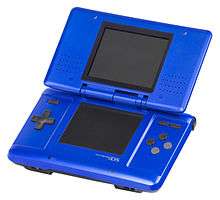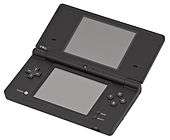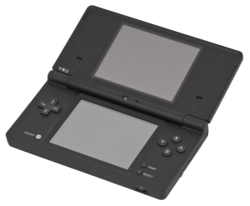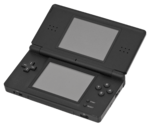Nintendo DS line
|
| |
| Developer | Nintendo |
|---|---|
| Type | Handheld game console |
| Generation | Seventh generation |
| Retail availability | 2004–2014 |
| Units shipped |
Worldwide: 154.01 million (as of December 31, 2014) |
| Media |
Physical and digital
|
| Best-selling game |
New Super Mario Bros., 30.80 million (as of March 31, 2016) |
| Backward compatibility | Game Boy Advance (DS, DS Lite only) |
| Predecessor | Game Boy line |
| Successor | Nintendo 3DS family |
The Nintendo DS line of handheld game consoles was developed and sold by Nintendo from 2004–2014. It succeeded the Game Boy Advance family and was succeeded by the Nintendo 3DS family in 2011.
Initially released as an experimental platform ancillary to the Game Boy line, the Nintendo DS line soon replaced it as Nintendo's flagship handheld device family. Featuring and interacting with many of the game series that are seen on the company's home console lines, the DS line has often represented the bulk of the company's unit system sales throughout the course of its history.
Throughout its lifetime, Sony's PlayStation Portable has been the main market competitor. There have been four different models of the Nintendo DS line on the market: the original Nintendo DS, the Nintendo DS Lite, as well as the Nintendo DSi and its XL variant. The Nintendo DS line has been highly successful, continuing the trend of its predecessor, the Game Boy line. With over 154 million units sold worldwide, the DS models are the best-selling handheld consoles, and second best-selling console overall behind the Sony PlayStation 2.
History
| 2004 | Nintendo DS |
| 2005 | |
| 2006 | Nintendo DS Lite |
| 2007 | |
| 2008 | Nintendo DSi |
| 2009 | Nintendo DSi XL |
| 2010 |
Timeline

Nintendo DS family
Nintendo DS

The Nintendo DS (abbreviated to DS) was a dual-screen handheld game console developed and released by Nintendo. The device went on sale in North America on November 21, 2004. The DS, short for "Developers' System" or "Dual Screen",[1] introduced distinctive new features to handheld gaming: an LCD screen working in tandem with a touchscreen, a built-in microphone, and support for wireless connectivity.[2] Both screens are encompassed within a clamshell design similar to the Game Boy Advance SP. The Nintendo DS also features the ability for multiple DS consoles to directly interact with each other over Wi-Fi within a short range without the need to connect to an existing wireless network. Alternatively, they could interact online using the now-discontinued Nintendo Wi-Fi Connection service.
Prior to its release, the Nintendo DS was marketed as a "third pillar" in Nintendo's console lineup, meant to complement the Game Boy Advance and GameCube. However, backward compatibility with Game Boy Advance titles and strong sales ultimately established the new handheld console as the successor to the Game Boy series.
Nintendo DS Lite

The Nintendo DS Lite (abbreviated to DS Lite) is a dual-screen handheld game console developed and manufactured by Nintendo. It is a slimmer, brighter, and more lightweight redesign of the original Nintendo DS. It was announced on January 26, 2006, more than a month before its initial release in Japan on March 2, 2006 due to overwhelming demand for the original model.[3] It has been released in Australia, North America, Europe, New Zealand, Singapore, and defined regions in South America, the Middle East, and East Asia. As of December 31, 2013, shipments of the DS Lite have reached 93.86 million units worldwide, according to Nintendo.[4]
Nintendo DSi

The Nintendo DSi (abbreviated to DSi)[5] is a dual-screen handheld game console released by Nintendo. The console launched in Japan on November 1, 2008, and worldwide beginning in April 2009. It is the third iteration of the Nintendo DS, and its primary market rival is Sony's PlayStation Portable (PSP). Development of the DSi began in late 2006, and the handheld was unveiled during an October 2008 Nintendo conference in Tokyo. Consumer demand convinced Nintendo to produce a slimmer handheld with larger screens than the DS Lite. Consequently, Nintendo removed the Game Boy Advance (GBA) cartridge slot to improve portability without sacrificing durability.
While the DSi's design is similar to that of the DS Lite, it features two digital cameras, supports internal and external content storage, and connects to an online store called the Nintendo DSi Shop. Nintendo stated that families often share DS and DS Lite consoles. Its new functionality was intended to facilitate personalization, so as to encourage each member of a household to purchase a DSi. The handheld supports exclusive physical media in addition to DS games with DSi-specific features and standard DS titles. The only exception to its backward compatibility are earlier DS games that required the GBA slot. As of September 30, 2014, Nintendo had sold 41.37 million DSi and DSi XL units combined.[4]
Reviews of the Nintendo DSi were generally positive; although IGN and bit-tech decried the console's lack of exclusive software and removal of the GBA cartridge slot, its added functionality caused many journalists to recommend it to those who had not purchased a previous DS model. Numerous critics were disappointed with the limited resolution of DSi's cameras, though others such as Ars Technica and GameSpot agreed they were adequate for the handheld's display. CNET and PCWorld considered the DSi Shop to be the most important buying incentive for current DS owners.
Nintendo DSi XL

The Nintendo DSi XL (abbreviated to DSi XL) features larger screens, and a greater overall size, than the original DSi. It is the fourth DS model, the first to be available as a pure size variation.[6] Iwata said that cost restraints had, until then, limited the screen size and multiplayer aspects of portable game consoles, and that the DSi XL offers "an improved view angle on the screens", which makes it the first "portable system that can be enjoyed with people surrounding the gamer."[6] He argued that this introduces a new method of playing portable video games, wherein those "surrounding the game player can also join in one way or the other to the gameplay."[6] While the original DSi was specifically designed for individual use, Iwata suggested that DSi XL buyers give the console a "steady place on a table in the living room," so that it might be shared by multiple household members.[6]
The DSi XL is the longest, widest and heaviest DS model.[5][7] The console features two 4.2-inch (110 mm) wide-viewing-angle LCD screens with the same resolution as the smaller model.[8] It has improved battery life over the DSi on all brightness settings; for example, batteries last 13–17 hours at the dimmest setting.[5] The handheld is outfitted with identical speakers contained in larger speaker enclosures, enabling them to produce louder sound. The hinges stop the screen at 120° in addition to the original DSi's position of 155° to allow easier table-top viewing.[9] The DSi XL is bundled with two longer styli, one of which is thicker, rounded, and pen-like,[10] and does not fit inside the unit.[11]
Comparison
| Name | Nintendo DSi XL | Nintendo DSi | Nintendo DS Lite | Nintendo DS |
|---|---|---|---|---|
| Logo | |
|
|
|
| Console |  |
 |
 |
 |
| In production | Discontinued | |||
| Generation | Seventh generation | |||
| Release date |
|
|
|
|
| Launch price | ¥20,000 US$189.99[13] €179.99 £159.99 A$299.95 |
¥18,900 US$169.99 €169.99 £149.99 A$299.95 |
¥16,800 US$129.99 €149.99 £99.99 A$199.95 |
¥15,000[12] US$149.99[12] €149.99 £99.99 A$199.95 |
| Current price | Discontinued | Discontinued | Discontinued | Discontinued |
| Units shipped | Worldwide: 154.01 million (as of September 30, 2015) | |||
| Best-selling game | New Super Mario Bros., 30.79 million units (as of March 31, 2015) | |||
| Display | 4.2 in (107 mm) | 3.25 in (83 mm) | 3.12 in (79 mm) | 3.0 in (76 mm) |
| 256 × 192 px (both screens)[12] | ||||
| 262,144 colors[14] | ||||
| 5 brightness levels | 4 brightness levels | Backlight On/Off toggle | ||
| Processor | 133 MHz ARM946E-S & 33.514 MHz ARM7TDMI | 67.028 MHz ARM946E-S & 33.514 MHz ARM7TDMI | ||
| Memory | 16 MB PSRAM | 4 MB SRAM (expandable via Game Boy Advance slot) | ||
| Camera | Front-facing and outward-facing 0.3 MP sensors | None | ||
| Storage | Expandable up to 32 GB via SD/SDHC card slot | None | ||
| Physical media | Nintendo DS Game Card (8-512 MB) | Nintendo DS Game Card (8-512 MB) Game Boy Advance Game Cartridge (2–32 MB) | ||
| Input controls |
|
| ||
| Battery | 1050 mAh lithium-ion battery
|
840 mAh lithium-ion battery
|
1000 mAh lithium-ion battery
|
850 mAh lithium-ion battery
|
| Connectivity | ||||
| Stylus | 96 mm (3.8 in) long × 4.9 mm (0.19 in) wide | 92 mm (3.6 in) long × 4.9 mm (0.19 in) wide | 87.5 mm (3.44 in) long × 4.9 mm (0.19 in) wide | 75 mm (3.0 in) long × 4 mm (0.16 in) wide |
| Weight | 314 grams (11.1 oz) | 214 grams (7.5 oz) | 218 grams (7.7 oz) | 275 grams (9.7 oz) |
| Dimensions |
161 mm (6.3 in) W |
137 mm (5.4 in) W |
133 mm (5.2 in) W |
148.7 mm (5.85 in) W |
| Online services | Nintendo Wi-Fi Connection
|
Nintendo Wi-Fi Connection | ||
| Preloaded applications |
|
|
| |
| Regional lockout | Yes | No | ||
| Backward compatibility | N/A | Game Boy Advance Game Pak (single-player only) | ||
See also
References
- ↑ "Nintendo DS Frequently Asked Questions". Nintendo. Retrieved 8 October 2013.
- ↑ Darkain (2005-01-21). "Nintendo DS – WI-FI vs NI-FI". Archived from the original on 2005-02-17. Retrieved 2006-04-02.
- ↑ Rojas, Peter (2006-02-20). "The Engadget Interview: Reggie Fils-Aime, Executive Vice President of Sales and Marketing for Nintendo". Engadget. Retrieved 2006-06-01.
- 1 2 "Consolidated Sales Transition by Region" (PDF). Nintendo. 2014-10-28. Retrieved 2015-01-16.
- 1 2 3 "ニンテンドーDSi LL:スペック" (in Japanese). Nintendo. Archived from the original on 2011-07-22. Retrieved 2009-11-09.
- 1 2 3 4 Satoru Iwata (2009-10-30). "Corporate Management Policy Briefing / Semi-annual Financial Results Briefing". Nintendo. pp. 9–10. Archived from the original on 2009-11-06. Retrieved 2009-11-09.
- ↑ Anoop Gantayat (2006-02-10). "DS Lite Colors Revealed". IGN. Fox Interactive Media. Archived from the original on 2009-02-03. Retrieved 2009-12-03.
- ↑ Masato Kuwahara; Masaki Amano; Kazou Yoneyama; Takaki Fujino (2009-11-30). "Nintendo DSi XL". Iwata Asks (Interview: Transcript). Interview with Satoru Iwata. Kyoto, Japan: Nintendo. p. 2. Archived from the original on 2010-11-26. Retrieved 2010-02-11.
- ↑ Masato Kuwahara; Masaki Amano; Kazou Yoneyama; Takaki Fujino (2009-11-30). "Nintendo DSi XL". Iwata Asks (Interview: Transcript). Interview with Satoru Iwata. Kyoto, Japan: Nintendo. p. 4. Archived from the original on 2011-09-07. Retrieved 2010-02-11.
- ↑ Nintendo 2009, p. 111.
- ↑ Chris Kohler (2010-02-01). "Product reviews: Nintendo DSi XL". Wired. Condé Nast Publications. Archived from the original on 2010-08-12. Retrieved 2010-04-07.
- 1 2 3 4 5 6 7 8 9 "Nintendo DS Fact Sheet". gamecubicle.com. Retrieved October 8, 2012.
- ↑ "Nintendo Reveals Hardware and Software Lineup for the First Half of 2010 – IGN". Uk.wii.ign.com. 2010-02-24. Retrieved 2014-03-12.
- ↑ "Nintendo DS Lite Specs (Polar White) – Consoles – CNET Reviews". Reviews.cnet.com. Retrieved 2014-03-12.
- 1 2 Nintendo DSi/Nintendo DSi XL – Battery FAQ Nintendo – Consumer Service
- ↑ Nintendo DS Lite – Battery FAQ Nintendo – Consumer Service
- ↑ DSi Operations Manual Nintendo – Support
- ↑ Nintendo Wifi Support FAQ – Nintendo.com